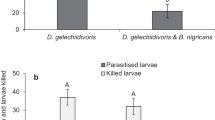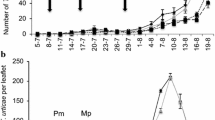Abstract
Brevipalpus phoenicis (Geijskes) is associated with the transmission of Citrus leprosis which is considered the main viral disease for the Brazilian citrus production. Mites of the families Stigmaeidae and Phytoseiidae coexist in various agricultural crops, often promoting the biological control of pest mites. The aim of this work was to study the interactions of Neoseiulus californicus (McGregor) (Phytoseiidae) and Agistemus brasiliensis Matioli, Ueckermann & Oliveira (Stigmaeidae), in the presence or absence of B. phoenicis. Two experiments were carried out. In the first, a N. californicus female was placed in each leaf disc arena, with eggs of B. phoenicis and A. brasiliensis as food sources. In the second, an A. brasiliensis female was placed in each arena, with eggs of B. phoenicis and N. californicus as food sources. Adults of both predators were able to consume both types of eggs available as food sources, but they fed on considerably higher proportions of B. phoenicis than on eggs of the predator. Eggs of A. brasiliensis were not a suitable food source for N. californicus, which produced only 0.1 egg per female per day when only eggs of that species were present in the experimental unit. The results suggest that eggs of N. californicus were a suitable food source for A. brasiliensis, which oviposited 1.12 eggs per day, when only eggs of N. californicus were provided to the stigmaeid mite. The possible interactions among N. californicus, A. brasiliensis and B. phoenicis in citrus orchards are discussed.


Similar content being viewed by others
References
Ahmedab N, Wanga M, Shua S, Radyb GH, Wangc Z (2013) Efficacy of pea flour as an antifeedant against two stored-food mites (Acari: Acaridae) fed on dried medicinal Chinese herbs. Int J Acarol 39:311–316
Alberti G, Tassi AD, Kitajima EW (2014) Anatomy and fine structure of Brevipalpus mites (Tenuipalpidae): economically important plant-virus vectors—Part 6: female reproductive system. In: Alberti G, Kitajima EW (eds) Anatomy and fine structure of Brevipalpus mites (Tenuipalpidae): economically important plant-virus vectors. Zoologica 160: 145–172
Canlas LJ, Amano H, Ochiai N, Takeda M (2006) Biology and predation of the Japanese strain of Neoseiulus californicus (McGregor) (Acari: Phytoseiidae). Syst Appl Acarol 11:141–157
Castagnoli M, Liguori M (1991) Laboratory observations on duration of copulation and egg production of 3 phytoseiidae species fed on pollen. In: Schuster R, Murphy PW (eds) The acari: reproduction, development, and life history strategies, 1st edn. Chapman and Hall, New York, pp 231–239
Clements DR, Harmsen R (1990) Predatory behaviour and prey-stage preferences of stigmeid and phytoseiid and their potential compatibility in biological control. Can Entomol 122:321–328
Clements DR, Harmsen R (1992) Stigmaeid-phytosiid interactions and the impact of natural enemy complexes on plant-inhabiting mites. Exp Appl Acarol 14:327–341
Clements DR, Harmsen R (1993) Prey preferences of adult and immature Zetzellia maliEwing (Acari: Stigmaeidae) Typhlodromus caudiglans Schuster (Acari: Phytoseiidae). Cand Entomol 125:967–969
Croft BA, MacRae IV (1992) Persistence of Typhlodromus pyri and Metaseiulus occidentalis (Acari: Phytoseiidae) on apple after inoculative release and competition with Zetzellia mali (Acari: Stigmaeidae). Environ Entomol 21:1168–1177
Croft BA, MacRae IV (1993) Biological control of apple mites: impact of Zetzellia mali (Acari: Stigmaeidae) on Typhlodromus pyri and Metaseiulus occidentalis (Acari: Phytoseiidae). Environ Entomol 22:865–873
Croft BA, McGroarty DL (1977) The role of Amblyseius fallacis (Acarina: Phytoseiidae) in Michigan apple orchards. Michigan State University Agricultural Experiment Station Research Reports, East Lansing, n. 333, p 22
MacRae IV, Croft BA (1996) Differential impact of egg predation by Zetzellia mali (Acari: Stigmeidae) on Metaseiulus occidentalis and Typhlodromus pyri (Acari: Phytoseiidae). Exp Appl Acarol 20:143–154
Matioli AL, Oliveira CAL (2007) Biologia de Agistemus brasiliensis Matioli, Ueckermann & Oliveira (Acari: Stigmaeidae) e sua potencialidade de predação sobre Brevipalpus phoenicis (Geijskes) (Acari: Tenuipalpidae). Neotrop Entomol 36:557–582
Matioli AL, Ueckermann EA, Oliveira CAL (2002) Some stigmaeid and eupalopsellid mites from citrus orchards in São Paulo State, Brazil (Acari: Stigmaeidae: Eupalopsellidae). Int J Acarol 28:109–120
McMurtry JA (1977) Some predaceous mites (Phytoseiidae) on citrus in the Mediterranean region. Entomophaga 22:19–30
McMurtry JA, Croft BA (1997) Life styles of phytoseiid mites and their roles as biological control agents. Annu Rev Entomol 42:291–321
Monteiro LB (2001) Seletividade de inseticidas a Neoseiulus californicus McGregor (Acari: Phytoseiidae) em macieira, no Rio Grande do Sul. Rev Bras Frutic 23:589–592
Moraes GJ (2002) Controle biológico de ácaros fitófagos com ácaros predadores. p 225–237. In: Parra JR, Botelho PSM, Corrêa-Ferreira BS, Bento JMS (eds) Controle biológico no Brasil: parasitóides e predadores. São Paulo, Manole, p 626
Moraes GJ, McMurtry JA (1981) Biology of Amblyseius citrifolius (Denmark and Muma) (Acarina: Phytoseiidae). Hilgardia 49:1–29
Moraes GJ, McMurtry JA, Denmark HA, Campos CB (2004) A revised catalog of the mite family Phytoseiidae. Zootaxa 434:1–494
Neves EM, Dragone DS, Dayoub M (2001) Demanda por defensivos na citricultura: análise comparativa com outras culturas comerciais. Laranja 22:286–297
Nunes MA, Oliveira CAL, Oliveira ML, Kitajima EW, Hilf ME, Gottwald TR, Freitas-Astúa J (2012) Transmission of Citrus leprosis virus C by Brevipalpus phoenicis (Geijskes) to alternative host plants found in citrus orchards. Plant Dis 96:968–972
PROMIP (2014) Biological products: Neoseiulus californicus. http://www.promip.agr.br/controle_biologico.php
Reis PR, Chiavegato LG, Alves EB (1998) Biologia de Iphiseiodes zuluagai Denmark & Muma (Acari: Phytoseiidae). An Soc Entomol Br 27:185–191
Rodrigues JCV, Kitajima EW, Childers CC, Chagas CM (2003) Citrus leprosis virus vectored by Brevipalpus phoenicis (Acari: Tenuipalpidae) in citrus in Brazil. Exp Appl Acarol 30:161–179
Sabelis MW (1985) The Phytoseiidae: capacity for population increase. In: Helle W, Sabelis MW (eds) Spider mites: their biology, natural enemies and control. Elsevier Science, 1(b):35–41
Santos MA, Laing JE (1985) Stigmaeid predators. In: Helle W, Sabelis MW (eds) Spider mites: Amsterdam, The Netherlands: Elsevier Science Publishers pp 197–203
SAS Institute (2008) The SAS (Statistical Analysis System) for Windows, version 9.2. SAS Institute Inc., Cary, NC
Sato ME, Raga A, Cerávolo LC, Souza Filho MF, Rossi AC, Moraes GJ (2001) Effect of insecticides and fungicides on the interaction between members of mite families Phytoseiidae and Stigmaeidae on citrus. Exp Appl Acarol 25:809–818
Sato ME, Silva MZ, Gonçalves LR, Souza Filho MF, Raga A (2002) Toxicidade diferencial de agroquímicos a Neoseiulus californicus (McGregor) (Acari: Phytoseiidae) e Tetranychus urticae Koch (Acari: Tetranychidae) em morangueiro. Neotrop Entomol 31:449–456
Silva MZ (2005) Potencialidade do Neoseiulus californicus (McGregor) (Acari: Phytoseiidae) na predação de ácaros fitófagos na cultura dos citros no Estado de São Paulo. Dissertation, UNESP (Universidade Estadual Paulista)
Silva MZ, Oliveira CAL (2006) Seletividade de alguns agrotóxicos em uso na citricultura ao ácaro predador Neoseiulus californicus (McGregor) (Acari: Phytoseiidae). Rev Bras Frutic 28:205–208
Silva MZ, Oliveira CAL (2007) Toxicidade residual de alguns agrotóxicos recomendados na citricultura sobre Neoseiulus californicus (McGregor) (Acari: Phytoseiidae). Rev Bras Frutic 29:85–90
Silva MZ, Sato ME, Oliveira CAL (2009) Seletividade de produtos fitossanitários sobre o ácaro predador Agistemus brasiliensis Matioli, Ueckermann & Oliveira (Acari: Stigmaeidae). Rev Bras frutic 31:388–396
Silva MZ, Sato ME, Oliveira CAL, Rais DS (2011) Toxicidade diferencial de agrotóxicos utilizados em citros para Neoseiulus californicus, Euseius concordis e Brevipalpus phoenicis. Bragantia 70:87–95
Silva MZ, Sato ME, Oliveira CAL, Veronez B (2012) Toxicidade de agroquímicos ao ácaro-da-leprose dos citros Brevipalpus phoenicis (Geijskes) e ao ácaro predador Neoseiulus californicus (McGregor) (acari: Tenuipalpidae, Phytoseiidae). Arq Ins Biol 79:363–370
White ND, Laing JE (1977) Some aspects of the biology and laboratory life table of the acarine predator Zetzellia mali. Can Entomol 109:1275–1281
Woolhouse MEJ, Harmsen R (1987) A transition matrix model of seasonal changes in mite populations. Ecol Model 37:167–189
Yamamoto PT, Gravena S (2001) Influência da dieta na oviposição de Iphiseiodes zuluagai Denmark & Muma (Acari: Phytoseidae). Rev Bras Frutic 23:82–86
Acknowledgments
The authors are thankful to FAPESP (São Paulo Research Foundation) for the financial support to this research (Processes 2008/52691-9 and 2013/05829-3) and for the Postdoctoral fellowship to Marcos Zatti da Silva (Process 2009/08789-7); also, thanks go to CNPq-Brazil (The National Council for Scientific and Technological Development) for providing the research fellowship to the second author. We are also grateful to Dr. Gilberto José de Moraes (ESALQ/USP) for the identification of N. californicus, and to Dr. André Luiz Matioli (Biological Institute) for the identification of A. brasiliensis.
Author information
Authors and Affiliations
Corresponding author
Rights and permissions
About this article
Cite this article
da Silva, M.Z., Sato, M.E., de oliveira, C.A.L. et al. Interspecific interactions involving Neoseiulus californicus (Acari: Phytoseiidae) and Agistemus brasiliensis (Acari: Stigmaeidae) as predators of Brevipalpus phoenicis (Acari: Tenuipalpidae). Exp Appl Acarol 65, 319–329 (2015). https://doi.org/10.1007/s10493-014-9874-z
Received:
Accepted:
Published:
Issue Date:
DOI: https://doi.org/10.1007/s10493-014-9874-z




